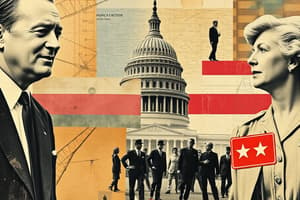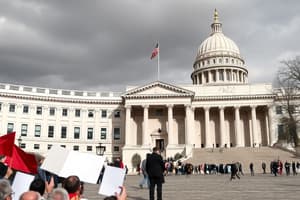Podcast
Questions and Answers
Which of the following scenarios best illustrates the concept of federalism in the United States?
Which of the following scenarios best illustrates the concept of federalism in the United States?
- A state government legalizes recreational marijuana, despite the federal government still classifying it as a controlled substance. (correct)
- Congress passes a law that standardizes all traffic laws across the United States, ensuring uniformity in every state.
- The federal government mandates a national curriculum for all public schools, overriding state educational standards.
- The President negotiates a treaty with a foreign country, which then becomes law without state approval.
The Articles of Confederation, adopted in 1781, suffered from several weaknesses. Which of the following was a significant deficiency that led to its eventual replacement by the Constitution?
The Articles of Confederation, adopted in 1781, suffered from several weaknesses. Which of the following was a significant deficiency that led to its eventual replacement by the Constitution?
- The lack of a national court system to resolve disputes between citizens of different states.
- The explicit prohibition of states from forming alliances or treaties with foreign nations.
- The inability of the central government to effectively tax and regulate interstate commerce. (correct)
- The excessive power granted to the executive branch, leading to concerns of potential tyranny.
The Bill of Rights comprises the first ten amendments to the Constitution. Which of the following BEST describes their primary purpose?
The Bill of Rights comprises the first ten amendments to the Constitution. Which of the following BEST describes their primary purpose?
- To establish the principle of federalism and divide powers between the state and federal governments.
- To guarantee equal rights and opportunities for all citizens, regardless of race, gender, or religion.
- To enumerate specific civil liberties and protect individuals from potential government overreach. (correct)
- To define the structure and powers of the three branches of the federal government.
The Constitution establishes a system of checks and balances. Which of the following scenarios exemplifies this principle in action?
The Constitution establishes a system of checks and balances. Which of the following scenarios exemplifies this principle in action?
Which statement accurately describes a disadvantage of federalism?
Which statement accurately describes a disadvantage of federalism?
Flashcards
What is Government?
What is Government?
A system or organization for exercising authority over a body of people.
What is Federalism?
What is Federalism?
A framework where power is divided between national and state governments.
What is the Bill of Rights?
What is the Bill of Rights?
The first 10 amendments to the Constitution protecting individual rights.
Creating the Constitution
Creating the Constitution
Signup and view all the flashcards
What is the Preamble?
What is the Preamble?
Signup and view all the flashcards
Study Notes
- A government is an institution that creates/enforces laws, provides public services, maintains order, and protects rights.
- Different types of governments include monarchies, oligarchies, direct democracies and representative democracies.
- Governments regulate public goods (national defense, clean air) and private goods (personal property).
- Elite Theory states that a small, wealthy elite controls the government.
- Pluralist Theory states that multiple groups compete to influence decisions.
- Policy decisions may involve compromises between different groups and interests.
- Democratic engagement encompasses voting, protests, lobbying, and general civic involvement.
- Political efficacy relates to individuals believing their actions can influence government.
- Barriers to engagement include voter suppression, political apathy, and not enough information.
Pre-Revolutionary Influences
- John Locke’s Natural Rights states that life, liberty, and property should be protected by the government.
- Social Contract Theory states governments derive power from the consent of the governed.
Articles of Confederation (1781-1789)
- The Articles were the first governing document of the U.S., producing a weak national government with no power to tax or regulate trade.
- The articles led to issues like Shay’s Rebellion, which highlighted the need for a stronger government.
Creating the Constitution (1787)
- The Great Compromise established a bicameral legislature, one house based on population (House), the other with equal representation (Senate).
- Enslaved people counted as 3/5 of a person for representation and taxation due to the Three-Fifths Compromise.
- Separation of Powers divides government into legislative, executive, and judicial branches.
- Checks and Balances allows each branch to limit the power of the others like presidential veto or judicial review.
Ratification and the Bill of Rights
- Federalists supported a strong central government while Anti-Federalists wanted states’ rights.
- The first 10 Amendments, known as the Bill of Rights, protect each individual's liberties.
Federalism and the Division of Powers
- Federalism is a system where power is shared between national and state governments.
- Enumerated Powers are federal powers to coin money, declare war, and regulate trade.
- Reserved Powers are state powers over education and local law enforcement.
- Concurrent Powers are shared, covering taxation, law enforcement, and building roads.
Evolution of Federalism
- Dual Federalism (Layer Cake, 1789-1930s) defines clear separation of state and federal responsibilities.
- Cooperative Federalism (Marble Cake, 1930s-present) defines overlapping responsibilities, with more federal involvement in state affairs like New Deal programs.
- New Federalism (1970s-present) saw some power return to states through block grants.
- Federalism encourages local decision-making, innovation, and political participation which are pros.
- Federalism can create inequality between states, conflict over national vs. state authority, inefficiencies which are cons.
Key Points from the Constitution Readings
- The Preamble establishes the goals of the U.S. government: justice, liberty, defense, welfare, and unity.
- Article I covers the Legislative Branch (Congress: House & Senate).
- Article II covers the Executive Branch (President & federal agencies).
- Article III covers the Judicial Branch (Supreme Court & lower courts).
- Article IV covers state relations and federalism principles.
- Article V covers the amendment process.
- Article VI, Supremacy Clause, federal law overrides state law.
- Article VII covers the ratification process.
Bill of Rights (First 10 Amendments)
- 1st Amendment: Freedom of speech, religion, press, assembly, petition.
- 2nd Amendment: The right to bear arms.
- 4th Amendment: Protection against unreasonable searches and seizures.
- 5th Amendment: Right to due process, no self-incrimination.
- 6th Amendment: Right to a fair trial
- 10th Amendment: Powers not given to the federal government belong to the states.
Studying That Suits You
Use AI to generate personalized quizzes and flashcards to suit your learning preferences.




